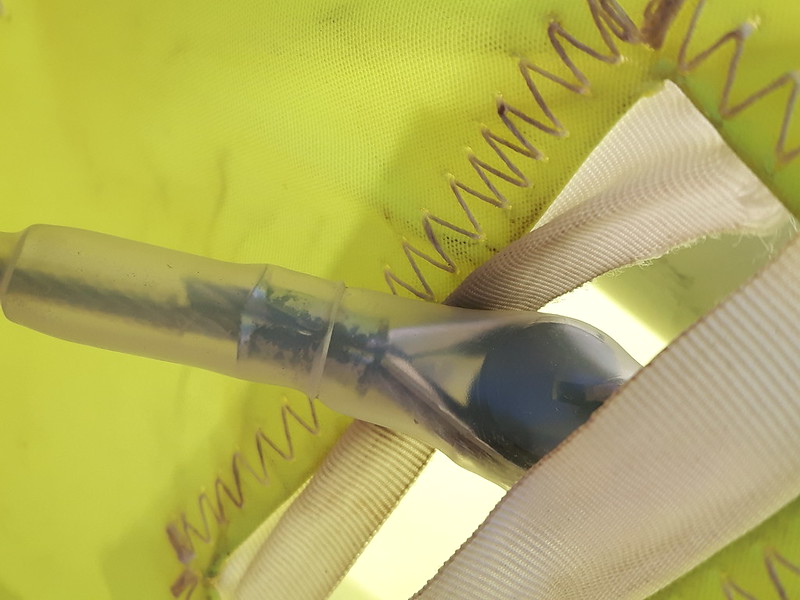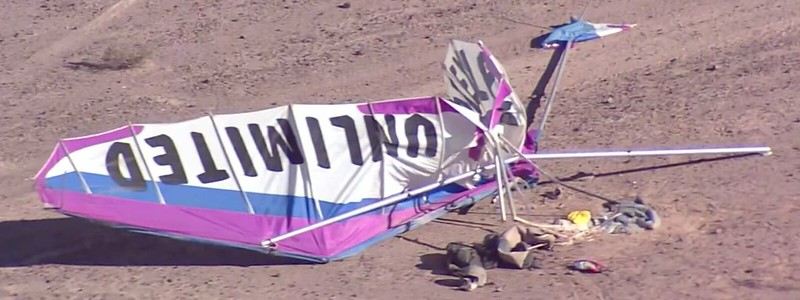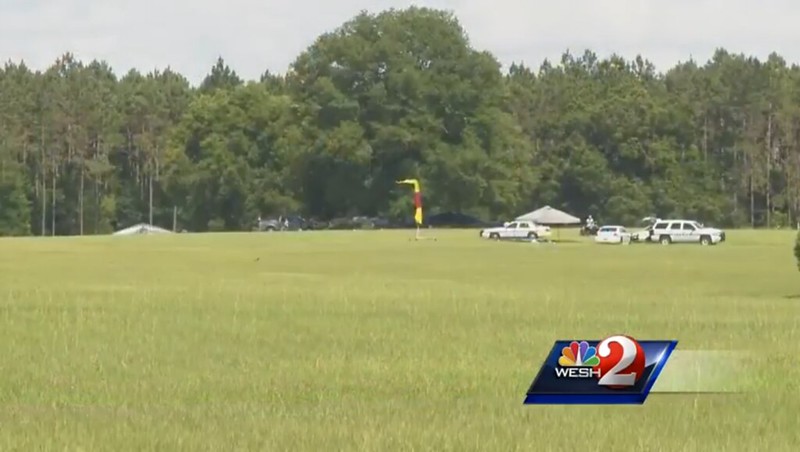http://www.hanggliding.org/viewtopic.php?t=35187
Nicopress corrosion - is this what it looks like?
Fuck yeah. NOBODY has ever fallen from his glider to his death who was questioning his hook-in status on the ramp and it's a good bet that precious few people have fallen out of the sky from failures of sidewires about which they had had concerns. I do the stomp test after every setup and before every breakdown and I never put the issue totally to rest.
Ken Howells - 2017/03/20 18:45:29 UTC
San Bernardino
Nickel
A "nico" is copper with nickel plating.
In my _personal_ opinion based on looking at your photos that black stuff you see is just surface discoloration of the nickel plating. The strength of the nico is inside where the copper flowed around the steel strands when it was pressed on.
Bull's-eye.
That said, annual replacement of your side wires is a really good idea.
Still a dickhead though.
NMERider - 2017/03/20 19:20:30 UTC
Do the side wire stomp test. It's in the manual.
Ever wonder why it isn't in ALL manuals? It's as solid and crucial as the hook-in check and there's no sane argument to the contrary. Shouldn't the fact that only one manufacturer (the world's largest, by the way) specifies it in its manuals set off some alarm bells about the general competence of the sport?
Comet - 2017/03/20 21:26:32 UTC
That test has always bothered me.
Well then you shouldn't do it. You should just go ahead and fly the glider from the manufacturer that doesn't know what it's talking about on the assumption that it's good on everything else.
It seems abusive to wires...
Then it undoubtedly IS. So you should always wait until you come off the ramp or runway to start abusing your wires. That way they'll experience the minimum possible level of abuse.
...and could actually precipitate a problem.
Never in the recorded history of hang gliding has it ACTUALLY precipitated a problem - but it COULD. So therefore it would obviously be totally insane to fly your glider glider in compliance with the manufacturer's published owner's manual.
It's kinda like saying "smash your helmet against the ground before every flight to make sure it's impact-worthy."
Yeah. Great analogy. A helmet which is designed to do its job ONCE and then be thrown away and replaced versus a glider which is designed to hold fine at six Gs and be looped and pulling three G loads an infinite number of cycles. Dickhead.
WingedGringo - 2017/03/20 21:33:46 UTC
Oatmeal Mountain, Arizona
NICO = NIckle and COpper
NiCo = Nickel-Copper
drachenjoe - 2017/03/20 22:16:52 UTC
Germany
Hmm,
corrosion on the nicopress sleeves can never result in black or dark-grey particles... Good advice from RED and NMERider btw..
Yeah, Red tells everyone to totally disregard the owner's manual and NEVER stomp the wires and Jonathan tells everyone to adhere to the owner's manual ALWAYS stomp the wires. But good advice from both of them.
PS : got 2 oldtimers last summer ( Bautek Pamir ) , built 1993. Factory checked in 1998, flown til 2000. Still the original downtubes and wires. Bautek manual :" when you are sure that the wires are "unharmed", they must NOT be replaced after a certain time or flights...".
No kinks, no broken filaments, sleeves not deformed, pressed as it should be - I don't worry, feel secure.
Scheisse happened only with wrong swageing or 1x19 "dental floss" side wires in aerobatics, as far as I know....
---
Flying since '76 : Homebuild Rhoenadler, Valkyrie, Sensor 210E. Actual : Bautek Pamir and Kite (Avatar).
Intelligent life forms discovered in hang gliding. Wattayaknow.
NMERider - 2017/03/21 02:20:41 UTC
Comet - 2017/03/20 21:26:32 UTC
That test has always bothered me. It seems abusive to wires and could actually precipitate a problem.
It's kinda like saying "smash your helmet against the ground before every flight to make sure it's impact-worthy."
Dude, you crack me up. Never change.

I'm also hoping he never changes.
Odd that they don't say anything about annual replacements - the way the Wills Wing manuals do, Campers.

Dave Jacob - 2017/03/21 04:12:15 UTC
Structural materials move through an elastic zone prior to experiencing permanent deformation as the load is applied. As long as you stay in the elastic regime you will not be...
So far, so good.
...appreciably damaging your glider.
What the fuck do you mean by "APPRECIABLY"? You won't be damaging anything AT ALL. Wanna talk about ACTUAL damage to your glider? Our sails don't improve with age, flight time, exposure to UV. This issue can result in changes into the lethal instability range if appropriate adjustments aren't made. So before you get all hyper about the totally fake stuff modify your behavior by either not flying at all or, failing that, limiting your flying to the hours between evening and morning Nautical Twilight.
If we were damaging components of our wings fractions of percentage points every time we got into the higher load spikes of normal flying we'd have gliders plummeting out of the sky left and right after they'd experienced a few good thermal weekends. Aerobatic pilots are loading to three Gs plus change all the freakin' time and they're not damaging their wires or spars tiny little degrees at every loop bottom.
So getting a decent estimate on the amount of force you are applying is important.
Bull fucking shit. How 'bout we offer a ten thousand dollar prize for anybody able to damage a glider...
http://ozreport.com/forum/viewtopic.php?t=24846
Is this a joke ?
Jim Rooney - 2011/08/26 02:44:10 UTC
See, in truck towing, a weaklink does next to nothing for you (unless the line snags).
This is because you're on a pressure regulated system... so the forces never get high enough to break the link.
This is not the case with an aerotow.
This is why the weaklink exists.
The forces of an aerotow can get high enough to tear the wings off the glider.
This is no exaggeration... it can be done.
http://ozreport.com/forum/viewtopic.php?t=31052
Poll on weaklinks
Jim Rooney - 2013/03/07 06:40:02 UTC
So... if it's *only* purpose is to prevent your glider from breaking apart... which is complete and utter bullshit... but if that was it's only purpose... why then do we have them at all?
Your glider will tear the rope apart before it breaks.
It will tear the towmast off the tug before it breaks.
Your glider is capable of amazing feats of strength... it is in no danger of folding up on you.
...by doing a stomp test of unlimited effort?
Red Howard - 2017/03/21 05:18:45 UTC
Dave,
You are correct, as far as the elastic zone is concerned, but I would have a hard time determining where that point might be, in the field.
Must be a real bitch to have such hard times determining so many things in the field. Gotta pity people permanently cursed with single digit IQs.
I stand with Comet on this one issue, and the problem here is stainless steel Work Hardening. Most stainless steel alloys are prone to Work Hardening.
- Funny we're not making our wires out of one of the stainless steel alloys that ISN'T prone to Work Hardening. Why do you think that is, Red?
- Capitalized Work Hardening. The absolute WORST KIND.
Repeated heavy stresses will cause the cable to become more brittle (work hardened)...
Bull fucking shit.
- We're not talking about anything within MILES of the neighborhood of "heavy stresses".
- "Heavy stresses" have shit to do with real world sidewire failures outside of blown aerobatic maneuvers - which don't concern us in the least.
- Even in the case of a blown aerobatic maneuver a 3/32 inch sidewire in airworthy shape will still be doing fine when a leading edge section or cross spar gives up the ghost.
- The issues of bends at the nicos and kinks anywhere along the lengths are pretty much all we've gotta worry about.
- If it were humanly possible to trash something on a glider by doing a stomp test - and I'm far from sure that it is - it wouldn't be a wire. Note that Wills Wing tells you to only stomp a T2 wire with two thirds of what they tell you to stomp a U2. That's not because they're using lighter wires on their toplesses.
- There isn't a five-year-old on the planet who'd have the least problem breaking a sidewire in the space of several minutes after a little push in right direction.
/\ \/ /\ \/ /\ \/ /\ \/ /\ \/ /\ \/ /\ \/ /\ \/
Got the idea, people of varying ages? THAT's WORK HARDENING. And it doesn't have shit to do with HEAVY STRESSES. It's all about sharp bends and it's physically impossible to sharply bend a wire with one's foot planted in its middle with the glider tensioned. And we put U-turn bends in the middles of all our flying wires every time we bag our gliders. And flying wires NEVER fail in their middles. And somebody should ask that dickhead to cite an example to the contrary - and let him know in no uncertain terms just how totally full o' shit he is when he can't.
...which is why I go with visual inspections and scheduled replacements of cables.
- What's your schedule, Red? And how was it determined?
- And we should disregard what Wills Wing's specifying in all their owners' manuals and follow your lead because you're so much more knowledgeable, intelligent, accomplished than they are. And I guess you need to keep your actual identity such a carefully guarded secret because otherwise you'd be totally overwhelmed by endless hordes of adoring campers.
Under normal flying conditions, the stresses are not a problem, but rodeo air and frequent whacks ARE a problem.
'Specially when there's no thimble elongation. Then the Work Hardening is completely undetectable. That's UNDOUBTEDLY what got Rafi.
Adjust your replacement schedules accordingly.
Suck my dick.
I do not agree with the Stomp Test;
Probably not global warming either. Chinese hoax - if you want my opinion.
...it may tell you that you should be safe today, but it may hasten the day when the cable fails, due to Work Hardening.
- Aren't we lucky to have Red standing as the last barrier to the deadly misinformation circulating today in fifty thousand Wills Wing glider owner's manuals. Can you imagine the absolute Work Hardening carnage we'd be seeing otherwise? I'd estimate around fifteen or twenty times the zero incidents we've seen to date.
- Let's say, for the sake of argument, that Work Hardening ISN'T just more of the unfathomable bullshit you pulled outta your ass. We're Work Hardening the wire by applying heavy stresses to the middle of the wire. When it's in flight it's not being heavily stressed and it's constantly arrow straight. So the wire's gonna break after six months of normal weekend schedule flying during PREFLIGHT. Big fuckin' deal. Just forces you to replace your wires at an even safer interval than the owner's manual specifies.
I have recently pulled flying wires to destruction that were over twenty years old (my own). They still pulled most of their rated strength, even that old.
- Obviously because they were never Work Hardened by idiots doing Stomp Tests. The ones that have been Work Hardened by idiots doing Stomp Tests practically fall apart in one's hands.
- So, people of varying ages, from this we can safely conclude that:
Every Year
In addition to the normal six month service items, also perform the following:
...
- Replace bottom side wires...
Is a total load o' shit (as Yours Truly has publicly maintained since the beginning of time).
Breaking strength is not the problem. With the old cables, what did fall right out of the tree was the Shock Load capability. New cables could accept shock loads that broke the old cables in one try.
Who could possibly argue otherwise in the face of solid data like that?
http://ozreport.com/forum/viewtopic.php?t=24846
Is this a joke ?
Jim Rooney - 2011/08/28 19:39:17 UTC
Weak links break for all kinds of reasons.
Some obvious, some not.
One of the biggest bits that seems to be under appreciated is the bit that weaklinks break under shock loading.
They can take a hell of a lot more force if they're loaded slowly... which is exactly what happens in a lockout.
(Funny manufacturers never seem to supply Shock in addition to Smooth Load Capacities.
This is the symptom of Work Hardening. You can not see it coming. Replace cables on a schedule, and that schedule needs adjustments to consider your flying in rodeo air, and landing whacks (both frequency and intensity).
So use Wills Wing's annual replacement if you never fly your glider then up the frequency from that baseline in accordance with whatever arithmetic you feel like pulling outta your ass to adjust for rodeo air and landing whacks.
Noisy landings are not good for your cables, nor the rest of the glider, for that matter.
So be sure to spend five or six weekends a month at the training hill perfecting your flare timing.
My $.02 worth.
Thanks bigtime, Red. Now all us muppets finally understand why we see so many more sidewire failures from the guys who fly rodeo air, whack their landings, do Stomp Tests. Shock Loading, Work Hardening, Inaccurate Scheduling.
What a Total Fucking Jack Show DickHead.
---
Edit - 2017/03/24 05:00:00 UTC
Posted one second after Steve's:
http://www.kitestrings.org/post10006.html#p10006
Undoubtedly a Kite Strings record.






